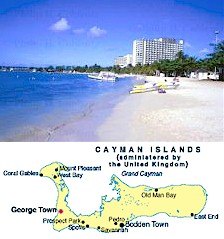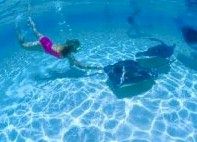|
Once a pirate stronghold, Grand Cayman is charming, prosperous and
utterly civilized today. There are duty free British shops filled with porcelain
and crystal, and the marvelous coral reef system alone makes a visit here
worthwhile.
|
|
HISTORY
The
three small Cayman Islands lie in the western Caribbean. Grand Cayman is
the largest of the three and home to the capital George Town.
These three small islands were first referenced by passing sailors in the 16th
century, who named them in reflection of the wildlife seen on the island and in
the surrounding sea: the Tortugas (turtles), then the Lagartos (alligators) and
finally the Caymans (crocodiles). Though occasionally used as
a water and food stopover for ships, the islands were not settled until the
1650's, when Jamaica was invaded. In
1670, the Spanish handed over Jamaica and
the Caymans to the British. The islands remained under the administration of
Jamaica and Britain for the next 300 years. Finally in 1960, when Jamaica became
independent, the Cayman Islands opted to become a Crown Colony and they continue to be governed by a representative of
the Queen of England.
|
 |
|
PLACES OF INTEREST |
|
Cayman Islands National
Museum
Housed in the
old courthouse building, on the George Town waterfront and close to the cruise
ship docks, this traditional museum contains many Cayman artifacts charting the
islands' history from geological formation to the present day.
|
|

|
Submarine Wall
Dive
Imagine exploring the legendary Cayman Wall on board a
sophisticated research submarine 800-feet below the sea! Cayman is the only
place in the world where the general public can experience
this ultimate
underwater adventure. Each excursion is very personalized with only two
passengers and one highly skilled pilot. You'll sit in front of a large 3 foot
diameter view port that is your window into this rarely seen world. Powerful
lights illuminate the brilliant colours of the sponge belt at 400-feet.
|
|
Seven mile beach
Seven-mile beach is by far the most popular beach on the island. Many of the
hotels border the beach and offer water sports, restaurants and bars. It is located on the west coast and a short drive from the pier. The water is
so clear that you can literally see the sandy bottom of the sea floor
while you are swimming.
|
|
Cayman Turtle
Farm
Visitors may observe
here the endangered green-sea turtle in
every stage of development. The farm breeds turtles to release into the sea for
conservation, but mostly to supply the large demand for turtle
meat which can be
tasted in the café.
|
|
Elizabeth II
Botanic Park
Situated in the
east half of the island, on the road leading inland and north from Frank Sound,
this 60-acre park is home to a variety of natural vegetation and animals,
including several rare species. Visitors follow a mile long trail through the
park, which incorporates resting points and ultimately leads to the visitor and
refreshment center.
|
|
ACTIVITY |
|
Make
questions corresponding to the highlighted sentences. Real answers have
been highlighted IN PINK. |
|